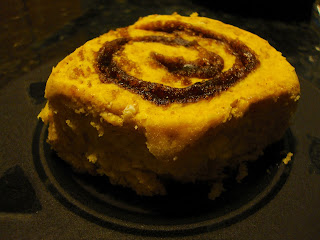 |
| Figure 1. It just takes time and thyme. And rosemary. |
Introduction
To be honest, we only made these potatoes because we thought we needed a side dish with the Mexican-Style Chicken. There was nothing particularly alluring about this recipe. The finished product was tasty, but doesn't hold a candle in comparison to our delicious Pumpkin Cinnamon Rolls. Really, after a dessert like that, who even needs to eat anything else? We do. Maybe we just needed more starch.
One day, we will make a dish with a better story, one of those "reminds me of what my grandmother used to make" sort of fuzzy anecdotes. Until then, please enjoy what we have to offer - a simple, restaurant-quality side to any delicious meat or vegetable you want for dinner.
 |
| Figure 2. Our NFPA Ratings for roasted rosemary-onion potatoes. |
Materials
 |
| Figure 3. Does that look like 1 inch to you? |
2) Onion, 1 small, finely chopped (.25 cup)
3) Olive or Vegetable Oil - 2 tablespoons
4) Rosemary - 2 tablespoons chopped fresh or 2 teaspoons dried
5) Thyme - 1 teaspoon chopped fresh or .25 teaspoon dried
6) Salt - .25 teaspoon
7) Pepper - .125 (1/8) teaspoon
Procedure
1) Heat your oven to 450 degrees Fahrenheit. Grease a 15.5 x 10.5 x 1 inch jelly roll pan. Cut potatoes into 1-inch chunks.
2) Mix everything else in a large bowl, then add your potatoes and toss them to coat them. After tossing, spread your potatoes in a single layer in your pan.
3) Bake uncovered for 20 to 25 minutes, turning occasionally, until potatoes are light brown and tender when pierced.
Explanation of our ranking (Fig. 2):
Prep time
The potatoes will sit in the oven for 25 ish minutes, so add the time you think it will take to mix everything together and spread. Depending on how meticulous you are about measuring your spices and spreading your potatoes, that can take anywhere from 5-10 minutes. It took us 15 minutes.
Difficulty
These potatoes were a cinch. One bowl, one pan, one oven setting. Can't get better than that.
Course
This is definitely a dinner go-with. When they are fresh, that is. They work as a lunchtime leftover side dish as well.
Results
4) Rosemary - 2 tablespoons chopped fresh or 2 teaspoons dried
5) Thyme - 1 teaspoon chopped fresh or .25 teaspoon dried
6) Salt - .25 teaspoon
7) Pepper - .125 (1/8) teaspoon
Procedure
1) Heat your oven to 450 degrees Fahrenheit. Grease a 15.5 x 10.5 x 1 inch jelly roll pan. Cut potatoes into 1-inch chunks.
2) Mix everything else in a large bowl, then add your potatoes and toss them to coat them. After tossing, spread your potatoes in a single layer in your pan.
3) Bake uncovered for 20 to 25 minutes, turning occasionally, until potatoes are light brown and tender when pierced.
Explanation of our ranking (Fig. 2):
Prep time
The potatoes will sit in the oven for 25 ish minutes, so add the time you think it will take to mix everything together and spread. Depending on how meticulous you are about measuring your spices and spreading your potatoes, that can take anywhere from 5-10 minutes. It took us 15 minutes.
Difficulty
These potatoes were a cinch. One bowl, one pan, one oven setting. Can't get better than that.
Course
This is definitely a dinner go-with. When they are fresh, that is. They work as a lunchtime leftover side dish as well.
Results
 |
| Figure 4. The final product. Simon and Garfunkel would be proud. |
The potatoes also came out slightly undercooked. They are still delicious that way, but if you prefer softer potatoes, we recommend leaving them in the oven for 5-10 more minutes.
Overall, these spuds provided a wholesome addition to the flavor palette on our plates. The strong flavor of the potatoes rounded out the relatively weak flavor of our chicken. This combination made for a great pre-PCR snack...otherwise known as "dinner."
Discussion
We've already provided you with a general review of starches (See Experiment 1, Discussion). Rather than continue to rave over starch, it's important to talk about more practical things with this recipe. For instance, the seasoning, specifically the rosemary, gets stuck in your teeth. This is annoying and makes this a risky dish unless you're eating alone or routinely carry dental floss in your pocket.
How do you choose between fresh or dried herbs? Dried herbs are more convenient, as they come prepackaged in airtight containers. Dried herbs also have a more concentrated flavor, which is why you can usually substitute 1 teaspoon of dried herb for every tablespoon of fresh herb (Television Food Network, 2012). However, dried herbs go stale quickly if they are not contained well. Fresh herbs have a more pure flavor, as well. If you are using dried herbs, take a quick sniff first to gauge their potency. Generally speaking, the longer they've been sitting in your spice rack, the more you'll have to use to achieve the same concentration of flavor.
Herbs lose their potency over time because the flavorants in herbs are proteins, and proteins fall apart when thy are exposed to light, heat, moisture, or anything else that disturbs the natural order of things. The same concept applies to a lot of pharmaceuticals too, for that matter. That's why you should keep your herbs in a cool, dry, dark place. Airtight jars in a cabinet work.
Future Directions
Coming soon: Pumpkin Cake Pops
References
Crocker, Betty. 2012. Roasted Rosemary-Onion Potatoes. General Mills.
Television Food Network. 2012. Using Fresh and Dried Herbs.


















